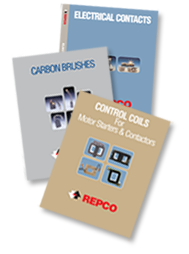
- Electrical Contacts
- Carbon Brushes
Carbon Brushes : Brush Reference
- Control Coils
Control Coils
- Other Contactor Parts
- More
- Search
- Auxiliary Contacts
Auxiliary Contacts
- Shunts
Shunts
- Springs
Springs
- ContactorsDC
ContactorsDC
- Fuses
Carbon Brushes Reference
Grades
The grade of the brush is usually found stamped on the face of the carbon. The grade indicates the material composition of the brush. It represents one of the more technical challenges in carbon brush applications.
Brush grades are usually classified according to the manufacturing processes and the types of materials used. The different grades in use today are derived through a variation of raw materials, molding pressures, temperature and duration of the baking process and after- treatments. These elements produce varied resistivity, hardness, and strength that in turn affect contact drop, friction and commutator filming. All grades fall within the four major categories of carbon graphite, electrographitic, graphite and metal graphite. The major characteristics of each category and a summary are listed below.
There are only a few major carbon block makers in the world. Each of these manufacturers can make as many as 100 different grades. Each grade is designed to perform under certain operating conditions. Careful consideration is given to the actual running loads, the duty cycle, the voltage, the speed and the environment. Repco, Inc. supplies product from these major carbon manufacturers.
In addition, there are also carbon brush fabricators. A fabricator purchases carbon block, cuts it to size, adds hardware and stamps its own grade designation on the face of the brush. Over the years, this practice has greatly added to the number of grades in the marketplace today. Our computer cross-reference system allows us to identify OEM and aftermarket brushes. Therefore, Repco, Inc. can supply carbon brushes for any motor including these major motor manufacturers:
- Baldor
- Century
- Electric Machinery
- General Electric
- Gettys
- Imperial
- Indiana General
- Leeson
- Lincoln
- Louis Allis
- Marathon
- Northwestern
- Pacific-Scientific
- Reliance
- U.S. Emerson
- Westinghouse
CARBON-GRAPHITE BRUSHES made their entrance early in the brush industry. Their properties of high hardness, material strength and pronounced cleaning action usually give long brush life under severe operating conditions, although they may not commutate as well as those with softer grades. These grades are limited to lower current densities and are used on slower machines, particularly those with flush mica commutators. The high friction generated with this type of material also makes it unattractive for some modern day applications.
ELECTROGRAPHITIC BRUSHES are baked at temperatures in excess of 2400 C. This process physically gives the material more of a graphitic structure. They generally have good commutating characteristics, but may not always be used because of high currents, or severe mechanical or atmospheric conditions. This material is fairly porous which permits treatment with organic resins. The treatments increase strength and lubricating ability which in turn helps increase brush life. These brushes are generally free from abrasive ash.
METAL GRAPHITE BRUSHES are generally made from natural graphite and finely divided metal powders. Copper is the most common metallic constituent, but tin, silver and lead are also used. This material is ideal for a variety of applications because of its low resistivity. Metal graphites are used on commutators of plating generators and wound rotor induction motors where low voltage and high brush current densities are encountered. They are also used for grounding brushes because of their low contact drop. These brushes exhibit a definite polishing action.
GRAPHITE BRUSHES are composed of natural or artificial graphite bonded with resin or pitch to form a soft brush material. Natural graphite usually contains ash, which gives the brush an abrasive, cleaning action. The fast filming properties of these brushes is beneficial in protecting the commutator or slip ring during operation in contaminated atmospheres. Their low porosity is also valuable in reducing commutator threading. They are not capable, however, of sustained operation at higher currents, like electrographic materials.
CARBON-GRAPHITE
- Used on older machines
- High strength and hardness
- Low resistance & poor commutation
- For machines that require some polishing action
- Generally, slower speed machines
GRAPHITE
- Good film characteristics
- Smooth ride
- Reduces threading
- Thermally limited
- Generally used on slip rings & FHP motors
METAL GRAPHITE
- Good for current densities
- Low contact drop
- Polishing action
- Metal content application
- 50% - material handling, battery charging & welding generators
- 60% - plating generators & rings
- 75% & up - rings & grounding brushes
ELECTROGRAPHITIC
- Good commutating ability
- Adequate strength with low abrasiveness
- Good friction characteristics
- Versatile
- Resistance, strength, hardness and density can be controlled through raw material combinations
- Very widely used today in all types of motors & generators for:
- steel and paper mills, excavation,
- cement, transportation & aerospace
Dimensional Measurements






Shunt Connections and Terminals




Metal Hammer Plates & Mica and Rubber Hard Tops



Special Features




Need Help Finding the Right Carbon Brush? Contact Us Today at 856-762-0172
Literature Request Or Download
Request our Electrical Contact, Carbon Brush, or Control Coil catalogs. Or download PDFs or browse them online.
Choose

Repco
100 Sonwil Drive
Buffalo NY 14225 - Control Coils
